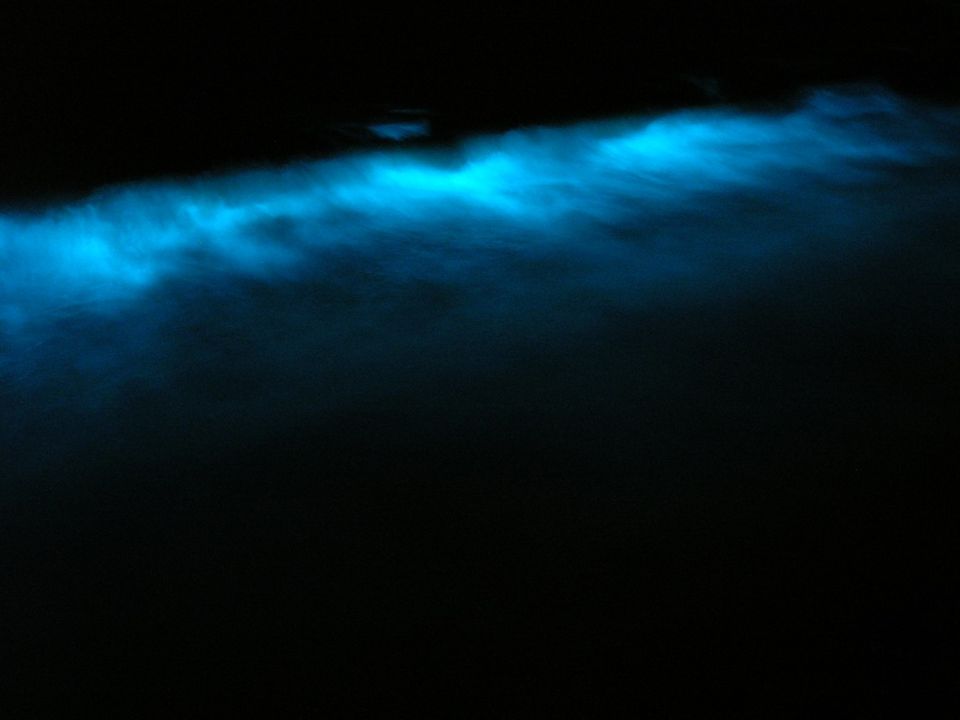To glow in the dark
Many organisms, including animals, plants and fungi, have the ability to create and emit light from their own bodies. This is called bioluminescence. The light is produced by their own enzymes and pigments reacting with oxygen molecules, or by bacteria generating light. In nature, bioluminescence is used in many different ways. It is most common in the oceans, but also occurs on land.
The deep sea angler fish has glowing fishing rod attached to its forehead. It lures prey, in the dark ocean, close to the angler fish's mouth.
Photo: NOAA-Photo-Library-CC-BY
Bioluminescence occurs in many species living in the ocean. Octopuses, squids, jellyfish and shrimp use bioluminescence to escape, intimidate, or to communicate with eachother.
Photo: Sierra-Blakely
Many species of comb jellies are bioluminescent. The photo shows the species Bathocyroe fosteri.
The deep sea shrimp Heterocarpus ensifer "vomits" bioluminescent fluid.
Photo: NOAA-Ocean-Explorer-CC-BY-SA
Bacteria can also glow in the dark.
Photo: Rob-Cruickshank-CC-BY
The bitter oyster fungus glows in the dark.
Fish with a glowing fishing rod
The deep-sea anglerfish lives at such great depths that sunlight cannot reach it. It uses bioluminescence to search for food. The deep-sea anglerfish has a modified fin at its head with a tip at the end. Bacteria that emit light live in the tip. The fin acts like a fishing rod, attracting fish which the deep-sea anglerfish then devours.

Photo: Frank.starmer-CC-BY
The glowing shell of scorpions
Almost all species of scorpions glow in a way called fluorescence. When the body of a scorpion receives UV light, for example during full moon nights, and the UV radiation is absorbed and re-emitted in the form of a blue-green glow. The blue-green light is at a wavelength that we humans can see, unlike UV. Scientists have long been trying to find out why scorpions glow in the dark. No one knows for sure, but it’s probably because the scorpion uses its whole body as one big eye. When substances in the scorpion’s shell react with the UV light, the scorpion knows it needs to be careful and hide.

Photo: Jed-from-San-Diego-CC-BY-SA
Confusing flashes of light at night
At the end of summer, you can sometimes see the water in the sea brighten up with a bluish green glow. This is known as the milky seas effect. The milky seas effect is caused by phytoplankton, which are small, single-celled algae. As phytoplankton are food for many animals, they need to protect themselves. By emitting flashes of light, they try to confuse or scare off attackers. The flashes can also attract larger fish that eat the plankton. In Sweden, the milky seas effect is most common along the west coast, but it also occurs in the Baltic Sea.
A fire beetle of the species Photinus pyralis.
Photo: art-farmer-CC-BY-SA
A species of firefly that may be found in Sweden.
Photo: Kadri-Niinsalu-CC-BY-SA
Fire beetles and fireflies
Despite its Swedish name (eldfluga), the fire beetle is actually, as the English name suggests, a flying beetle. It emits flashing lights as it flies around at night. It is usually the male that flashes. The flashing attracts females. In some species of fire beetles, the males flash together at the same rate. They do this so that the females can find their way around, and not be confused by male fire beetles of another species. Fire beetles are not found in Sweden, whereas fireflies are. This is, despite its name, another glowing beetle. There are about 100 species of fireflies around the world. Two of them can be found in Sweden. In this case it is the female that glows. She can’t fly, but sits in grass and on branches and radiates a green glow. The female can glow for several hours to attract males to mate with. But the males and larvae also glow dimly. The green light also signals that the firefly is not tasty and scares away animals that want to eat them.